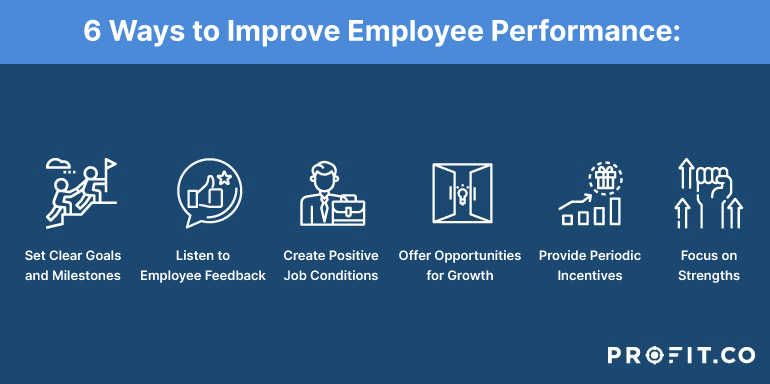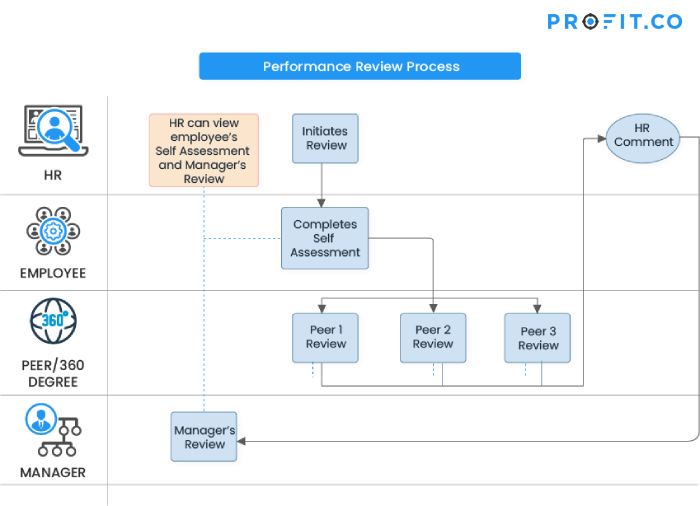Being a successful boss has so many different meanings. Some people will just assume that you are a good boss if your business has high-profit margins, while others see success correlating with having sizable company assets. However, the best indicator of success is how well your employees perform for you. As said by Stan Slap, CEO of Slap Company: “When you’re a manager, you work for your company. When you’re a leader, your company works for you.”
Motivated, content employees are much more likely to produce better results as compared to unhappy employees. When workers are satisfied with the job conditions, they will continue to strive towards performance improvement. There are many ways to improve employee performance in the workplace, we’ll discuss some of these methods below.
What Exactly is Employee Performance and Performance Management?
First and foremost, it is critical to identify what employee performance means to you as an employer. Employee performance is referring to the effectiveness and efficiency of an employee. If an employee is performing his job successfully, he will have a high output of completed work. Employees who perform well are incredibly valuable to organizations. They are providing a high return on investment for the company, and therefore they should be supported in their role as they continue to improve. As a leader, it is your job to figure out how to best support them and lead them towards both their personal goals and the company objectives.
When it comes to performance management, the main concept includes an employee and their supervisor singling out certain objectives that the organization should be working towards for the next quarter or year. The management portion comes in when the employee and supervisor remain in communication about the objectives throughout the entire timespan. There won’t be one big performance review at the end of the year, instead, they will constantly be working together to review and analyze results. The supervisor will guide the employee through setting goals, celebrating accomplishments, and providing constructive criticism. If the employee seems to be moving off track, the supervisor will be able to see where they are going wrong and guide them back to where they should be.
Profit.co’s performance module can help managers in guiding their employees. With performance reviews that target all facets of employee performance– rather than just the numbers– and highly customizable questions that encourage employees to self-reflect and address their own strengths and weaknesses, managers and employees can communicate more effectively than ever.
A manager is a coach and communicator, not a commander or controller.
Good performance accountability is about having a positive conversation between manager and employee.
The Importance of Employee Performance Improvement
A supervisor should always be aware if there is an underlying issue that is causing problems with an employee’s performance. If performance is lacking, potential issues could include:
- Insufficient training
- Distraction with another job/social media/other
- Overqualification
- Discomfort with job conditions
- Problems at home
The sooner that the supervisor addresses the issue, the sooner that it will be resolved. Maintaining communication with the employee will show them that they are cared about and valued in the workplace. If the employee is simply left alone with no intervention, they will come to understand that poor performance at work will be tolerated. They will not work to better themselves because they will have no motivation to do so, and they will be more likely to switch jobs as soon as a better paying one comes around.
Employees should always be feeling engaged and challenged (in a good way) at work. When they have high job satisfaction, they will be more receptive to working with you to improve their performance. This is because they will want to keep reaching to see how far they can get. The co-founder and partner of People Conscience spoke about performance management relating to employee satisfaction: “Performance management, when handled skillfully in an organization today, can increase job satisfaction, employee retention, loyalty, and overall performance of the organization.” Improving workplace performance is a good way for employees to continue advancing their way up the corporate ladder. It shows that they are serious about the job and that they want to use their skills to help the organization succeed.
The engagement module in Profit.co offers leaders and HR administrators the option to send out surveys to employees. If you want to assess the satisfaction of your employees at your company, you can send out a Pulse Survey to be answered anonymously or with employee-specification. This is an efficient and effective way to get specific, organized feedback from your employees, and can help you address any and all concerns pertaining to employee satisfaction before they become problems for your business.
How to Improve Employee Performance

Set Clear Goals and Milestones
Some supervisors work under the misconception that their employees automatically know everything that is expected of them. There is a lack of communication simply because one or both parties does not realize that the expectations are not matching the produced work. A common form of goal setting is to use the SMART acronym, which means to make sure that your goals are specific, measurable, attainable, relevant, and time-specific.
Transparency is a vital component of ensuring that your employees know what their focus should be. Using Objectives and Key Results (OKRs) in your company can help you be as transparent as possible not only about your own goals and the organization’s goals, but also concerning what the focus of your employees should be. By structuring your quarter around aspirational objectives and concrete, specific key results, you and your employees will have a record of what needs to be accomplished. With Profit.co’s OKR software, you can set weekly check-ins for your employees to complete on their key results, giving you a clear view of their progress and their focus. If expectations are not matching up between a manager and an employee, the OKR methodology will necessarily show this, prompting communication to get everyone back on track.
Setting clear goals means that everything is spelled out clearly and everyone is on the same page. The next step would be to create an individualized success plan for your employees. This will motivate your employees to become more productive in the future.
Listen to Feedback
A good supervisor is open to feedback and criticisms. Allow your employees to speak up about issues concerning them. Some of these issues may never have crossed your mind, so it is important to take note of what your employees have to say.
It can be difficult to get an accurate picture of what is happening in a workplace. However, with the 360-degree feedback feature in Profit.co’s performance module performance reviews become ways to determine not only how employees feel they are doing personally, but also how their peers feel about their performance. The 360-degree feedback feature collects assessments from an employee, their peers, as well as their manager– giving a full view of every perspective. With this information, managers can get a clear sense of how certain employees are performing and interacting with others. If there’s a miscommunication or an issue, this review process will reveal it.

Employees are working on the front-line of the business every day. They understand the daily operations better and which processes can be improved. They might have ideas on how to improve the workflow. By listening to your employees and making some changes, you are proving that you care about what they have to say. This is a huge motivational boost for employees, and they will be driven to continue bettering themselves at work.
Positive Job Conditions
As an employer, you should ensure that the working conditions are conducive to increase productivity. Employees should come into the office feeling refreshed and happy to be there.
Personalizing space has always had a great effect on employee performance. Encourage employees to bring items to work such as photographs and plants. Making a space of their own will give employees a sense of belonging than having to stare at blank cubicle walls all day. Having these personal items can also spark conversations between colleagues, making it feel as though everyone in the office is more connected to each other.
Connection does not only have to come from physically being in the office or in a meeting. Promote communication and interaction in the day-to-day tasks of your employees using the Tasks Management module in Profit.co’s software. This feature not only promotes organizational excellence and allows you to associate tasks directly to their corresponding key results– but it also includes the opportunity for your employees to comment on one another’s work and easily collaborate with one another.
Another thing to consider is flexibility. It is important to be understanding and work with your employees’ schedules. If you have an employee who needs to drop off her child at daycare in the mornings, do not give her a hard time about being late. Instead, talk with her about taking a shorter lunch, or working from home for an hour in the evenings. Providing flexibility to your employees will make them more motivated to work hard, as they will appreciate you helping them.
Offer Opportunities
In some companies, the only training that is offered is when the employee initially joins the company. Training should not end here. There should be ample opportunities for employees to learn new things. You should be making sure that there are courses or classes available for employees to take if they wish. This could be anything from an Excel skills course to diversity training.
Giving your employees the chance to continue learning at any stage in their lives will encourage them to continue moving up and not staying still. It will also better prepare them for any potential promotions that they might be interested in applying for.
If you have designated an employee with great potential and high performance, you can initiate an Individual Development Plan (IDP) from the performance module in Profit.co. This allows you to put employees on a promotion track, assigning them a mentor, as well as building a development plan where they might take a leadership class, attend seminars, or complete other tasks to improve their skills and prepare for an eventual promotion.
Provide Incentives
Workers who go day in and day out without any acknowledgment of their efforts start to feel burnt out and unmotivated. As said by Rajesh Padmanabhan, Chief Human Resources Officer at Welspun Group: “The sole purpose of Performance and Rewards management should be, to put up a process in place enabling employees in maximizing their capabilities and potential.” When you notice that one of your employees has gone above and beyond, it is important to take a moment to recognize their accomplishments. You can also use this as an opportunity to encourage further productivity which will result in more incentives.
Some incentives that you could offer include giving paid time off, sending a congratulatory email with a higher up cc’d on it, taking the team out for a meal, or organizing a team retreat as a fun event. Even something simple would be appreciated, such as saying “great job on XYZ today, I know it wasn’t easy, but you got it done right.” You are specifically mentioning the thing that the employee did right and acknowledging that it was a difficult task. That employee will feel much happier on their way home than they otherwise would have.
Focus on Strengths
Realistically, it is important to understand that your employees will not be equally talented in all areas of work. If you assign a quiet, introverted employee to make a sales pitch to a big client, you are likely to lose out on the sale and the employee will lose confidence in himself. Instead, ask that quiet employee to come up with the marketing pitch or cost breakdown. Then, assign the pitch to a more extroverted employee who can then make the sale to the client.
Knowing your employees’ strengths and weaknesses will better prepare you to allocate tasks and assignments. Show that you have paid attention to their individual personalities and they will greatly appreciate it. They will feel good about themselves knowing that they have the ability to perform the task and that they can get it done well.
Profit.co’s Performance Management Module
Profit.co permits you to do a self-assessment, in addition to the assessment done by the Managers and Peers. The potential vs. performance assessment is done with a 9-box matrix where the employee can move to take up IDP and move to leadership roles or to Performance Improvement Plan (PIP) where he is given scope to improve himself. Both self-assessments and 1 on 1 manager-employee reviews are based on competencies & graphic rating scales. Employees and managers can provide comments and use the interactive Graphic Rating Scale (GRS) to rate against competencies identified for each job title.
Giving employees the space to evaluate their performance in certain skill sets is not only a useful practice for their own understanding of their job, but it is always useful for managers to see how employees feel about each facet of their job. Superusers can associate certain competencies with certain departments within the Profit.co software to be used during performance reviews.
So, if all employees in the sales department should have excellent skills in communication, client relationships, and product knowledge, then those competencies can be associated with the Sales department, and when it comes time to conduct a performance review, they can evaluate their performance in these areas. Alternatively, a marketing department might have competencies such as attention to detail, creativity, and communication. This allows employees to reflect on the skills they should be constantly improving in their job, and managers to see where each employee’s strengths and weaknesses lie.
During a performance review, both the employee and the manager will rate these competencies. This gives a side-by-side view of how the employee feels they are performing, and how the manager is perceiving that performance. If the rating match, the competency will be highlighted as a Rating Match. If it does not match, therein lies an opportunity to discuss where the dissonance is coming from.
This point is succinctly summarized by Kevin Lyons, senior HR manager at Pearson: “A really effective Performance Management program is closely entwined with the needs of the organization and looks at talent development as central to the conversation, as well as embracing regular discussion and feedback.”
With the 360-degree feedback feature in Profit.co’s performance module performance reviews become ways to determine not only how employees feel they are doing personally, but also how their peers feel about their performance. The 360-degree feedback feature collects assessments from an employee, their peers, as well as their manager– giving a full view of every perspective. With this information, managers can get a clear sense of how certain employees are performing and interacting with others. If there’s a miscommunication or an issue, this review process will reveal it.
Performance management in Profit.co allows an organization’s management team to assess and review its employees. With a 360-degree assessment, both individual performance and the overall performance of the organization can be evaluated.
The Future of Employee Performance
Since the global pandemic known as Covid19 has started spreading, millions of people around the world have suddenly found themselves working from home. As a result of the pandemic, it is likely that many companies will implement work-from-home practices in order to save money on office space. With employees working in different locations rather than all together, it is more important than ever that you are attuned to how they are performing at their job.
Some workers might use the opportunity to slack off and not perform to their best ability. They will need to be monitored and you will need to remain in constant communication with them to check up on their goal progress. These types of employees often just need a reminder that you are all still a team, and they are being relied upon to carry out their tasks. Other workers may become despondent with nobody to talk to all day. For them, you could organize regular video conference meetings, which will give them back a sense of togetherness.
The flexibility of working from home will improve the job satisfaction of many employees because they are able to handle their personal responsibilities easier. There is also less of a need to miss work or take sick days because they can work around their commitments. They will also be able to work on days when they are feeling a little unwell and would not normally have come into the office. Due to the increase in job satisfaction, employees will strive to perform well at work and prove that they can be just as productive, if not more than they were at the office.
Conclusion
Paying attention to your workers’ needs and guiding them towards self-improvement is a sure-fire way to become a better boss. Employees need motivation and job satisfaction in order to fully commit to performance improvement. Once they feel happy in their role, they will strive towards improving themselves for both their own benefit and for the benefit of the company itself.
It can take some time before you are attuned to all your employee’s individual needs. However, the time that you are spending is a very worthwhile investment that will benefit you for years to come. You will be happier as well, simply by knowing that your employees are well taken care of and performing to the best of their ability.

